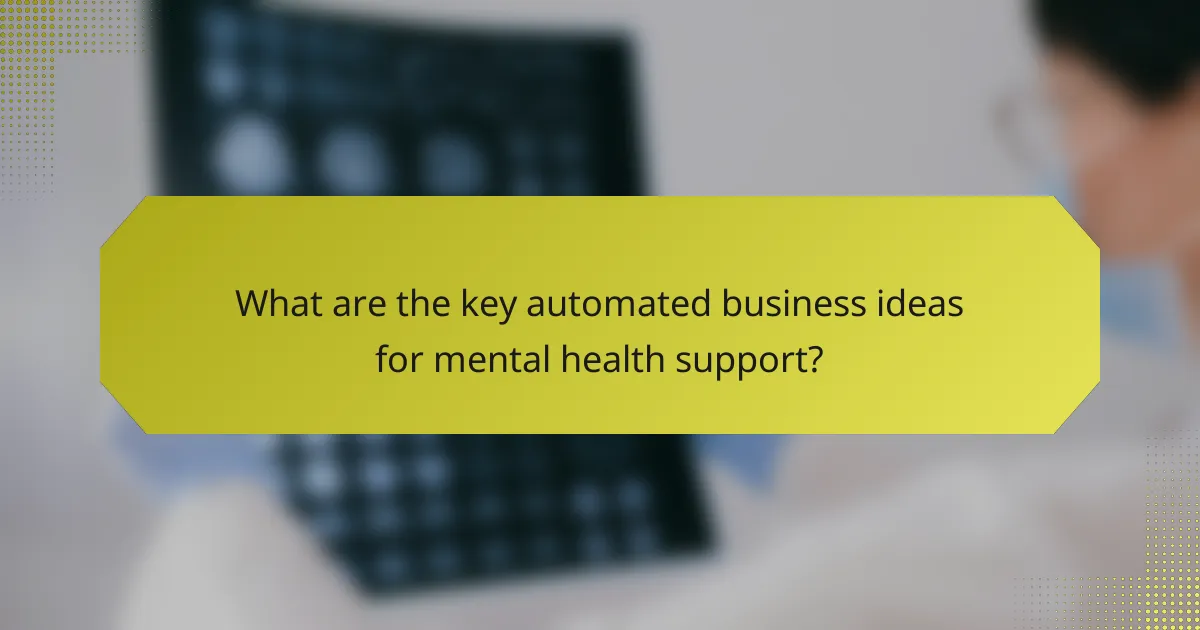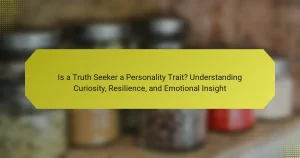Automated business ideas for mental health support offer innovative solutions to enhance wellbeing and accessibility. Explore how chatbots provide instant assistance, virtual therapy platforms connect users with therapists, wellness apps promote mental health practices, and AI-driven assessment tools recommend interventions. These technologies are transforming the landscape of mental health care by making support more available and personalised.

What are the key automated business ideas for mental health support?
Automated business ideas for mental health support include chatbots, virtual therapy platforms, wellness apps, and AI-driven assessment tools. These solutions enhance accessibility, provide immediate support, and personalise user experiences.
1. Chatbots for instant support: AI-powered chatbots offer 24/7 assistance, answering queries and guiding users to resources.
2. Virtual therapy platforms: These connect users with licensed therapists via video calls, making mental health services more accessible.
3. Wellness apps: Apps provide guided meditations, mood tracking, and cognitive behavioural therapy exercises to promote mental wellbeing.
4. AI-driven assessment tools: These tools analyse user responses to assess mental health conditions and recommend appropriate interventions.
How do technology-driven solutions enhance mental health services?
Technology-driven solutions significantly enhance mental health services by increasing accessibility, personalising care, and improving engagement. Automated platforms provide immediate support, allowing users to access resources anytime. Telehealth options expand reach, enabling remote consultations. Data analytics personalise treatment plans, ensuring tailored interventions. These innovations lead to better outcomes and increased patient satisfaction.
What role do chatbots play in mental health support?
Chatbots play a significant role in mental health support by providing immediate assistance and resources. They offer 24/7 availability, allowing users to access help anytime. Chatbots can deliver tailored coping strategies and self-help tips based on individual needs, enhancing user engagement and comfort. They also facilitate anonymous conversations, reducing stigma and encouraging users to seek help. Research shows that chatbots can effectively reduce symptoms of anxiety and depression, making them a valuable tool in mental health care.
How can chatbots provide immediate assistance?
Chatbots provide immediate assistance by offering real-time responses to inquiries, ensuring users receive support without delays. They can handle multiple queries simultaneously, reducing wait times. Additionally, chatbots can access vast databases for information, delivering accurate resources on mental health topics. Their availability 24/7 enhances accessibility, allowing users to seek help at any time. By integrating with other platforms, chatbots can streamline mental health services, connecting users with professionals when necessary.
What are the limitations of chatbot interactions?
Chatbot interactions have several limitations that can impact their effectiveness in mental health support. They often lack emotional understanding, which can hinder empathetic responses. Additionally, chatbots may struggle with complex queries or nuanced conversations, leading to miscommunication. Privacy concerns are also significant, as users may hesitate to share sensitive information. Finally, chatbots cannot replace human connection, which is crucial in mental health discussions.
What are the benefits of online therapy platforms?
Online therapy platforms offer increased accessibility, convenience, and a range of therapeutic options. Clients can engage in therapy from the comfort of their homes, eliminating travel time and barriers. These platforms often provide various communication methods, including video, chat, and messaging, catering to individual preferences. Additionally, online therapy can reduce stigma, making it easier for individuals to seek help. Research indicates that online therapy is as effective as in-person sessions for many mental health issues, enhancing overall wellbeing.
How do these platforms improve accessibility?
Automated business ideas for mental health support enhance accessibility through user-friendly interfaces and 24/7 availability. These platforms provide tailored resources, allowing users to access mental health support anytime and anywhere. Features like chatbots and teletherapy reduce barriers, ensuring immediate assistance. Additionally, they often include multilingual options, catering to diverse populations.
What features should be included in an effective online therapy platform?
An effective online therapy platform should include secure messaging, video conferencing, appointment scheduling, and progress tracking. These features enhance user experience and ensure confidentiality.
Secure messaging allows clients to communicate safely with therapists. Video conferencing enables real-time therapy sessions, fostering connection. Appointment scheduling simplifies booking and managing sessions. Progress tracking helps clients monitor their mental health journey, providing valuable insights.
How can mobile apps facilitate mental health education?
Mobile apps can enhance mental health education by providing accessible resources, personalised learning experiences, and interactive platforms for engagement. They offer features such as guided meditations, educational content, and community support. For example, apps can deliver evidence-based strategies to manage anxiety and depression, promoting awareness and understanding of mental health issues. As a result, users can improve their wellbeing through informed choices and self-care practices.
What types of content are most effective in mental health apps?
Engaging and personalised content types are most effective in mental health apps. These include interactive tools, guided meditations, mood tracking, and community support features.
Interactive tools, such as quizzes and self-assessment questionnaires, enhance user engagement and provide tailored feedback. Guided meditations offer users structured relaxation techniques, promoting mindfulness and reducing anxiety. Mood tracking allows users to monitor their emotional states, facilitating better self-awareness and progress tracking. Community support features foster connection, enabling users to share experiences and receive encouragement from peers.
Incorporating a variety of these content types can significantly enhance user experience and support mental wellbeing.
How can gamification enhance user engagement?
Gamification enhances user engagement by making mental health support more interactive and enjoyable. It leverages game-like elements to motivate users, fostering a sense of achievement and community. For instance, incorporating point systems or rewards can increase participation in wellness activities. This approach addresses unique attributes of user motivation, enhancing overall mental wellbeing.
What are the unique attributes of AI-driven mental health diagnostics?
AI-driven mental health diagnostics possess unique attributes that enhance accuracy and personalisation. These include real-time data analysis, predictive modelling, and adaptive learning capabilities. Real-time data analysis allows for immediate feedback, while predictive modelling identifies potential mental health issues before they escalate. Adaptive learning enhances the system’s effectiveness by tailoring interventions based on individual user responses. These attributes collectively improve the overall quality of mental health support.
What rare automated solutions are emerging in mental health support?
Automated solutions in mental health support are increasingly leveraging AI and machine learning. Emerging tools include chatbots for immediate emotional assistance, virtual reality for exposure therapy, and predictive analytics for personalised care. These innovations enhance accessibility and engagement, addressing rare needs in mental health management. For instance, AI-driven platforms can analyse user data to tailor interventions, significantly improving outcomes.
How are virtual reality experiences being used for therapy?
Virtual reality experiences are increasingly used in therapy to enhance mental health support. These immersive environments facilitate exposure therapy, allowing individuals to confront fears in a controlled setting. For example, VR can simulate social situations for those with social anxiety, helping them practice interactions. This method has shown effectiveness in reducing symptoms of PTSD, anxiety disorders, and phobias. Additionally, VR therapy can provide relaxation and mindfulness exercises, promoting overall wellbeing. As a result, automated solutions incorporating VR technology are emerging, offering scalable mental health interventions.
What innovative tools are available for mental health professionals?
Teletherapy platforms, mobile mental health apps, and AI-driven chatbots are innovative tools for mental health professionals. These solutions enhance accessibility, provide real-time support, and facilitate data collection. Teletherapy platforms enable remote consultations, improving client reach. Mobile apps offer self-help resources and tracking tools for mental wellness. AI chatbots provide immediate responses and can assist in triaging mental health concerns. These innovative tools collectively enhance the efficacy of mental health support services.
How can automated business models ensure sustainability in mental health support?
Automated business models can enhance sustainability in mental health support by providing scalable, accessible solutions. These models reduce operational costs while increasing service reach. For instance, AI-driven chatbots offer 24/7 support, addressing immediate needs without human resource constraints. Additionally, data analytics can track user engagement and outcomes, ensuring interventions are effective and tailored. As a result, these innovations foster a more resilient mental health support system that adapts to evolving demands.
What best practices should be followed when implementing automated solutions?
To implement automated solutions effectively, prioritise user needs, ensure data privacy, and maintain system reliability. Start with a clear understanding of mental health support requirements. Integrate user feedback to refine automation. Regularly update systems to adapt to evolving needs. Train staff to manage and oversee automated processes.
What common mistakes should be avoided in automated mental health services?
To enhance automated mental health services, avoid common mistakes such as neglecting user privacy, failing to provide personalised experiences, and not integrating professional support. These errors can undermine trust and effectiveness. Prioritise user engagement and feedback to improve service quality.
How can feedback loops improve automated mental health solutions?
Feedback loops enhance automated mental health solutions by continuously refining their effectiveness. These loops allow systems to gather user responses, analyse outcomes, and adjust interventions accordingly. For instance, regular user feedback can identify which features are most beneficial, leading to improved user engagement and satisfaction. This iterative process ensures that solutions remain relevant and responsive to individual needs, ultimately fostering better mental health outcomes.
What future trends in automated mental health support should be monitored?
Automated mental health support will increasingly incorporate AI-driven personalised interventions, real-time monitoring, and data analytics. These trends will enhance user engagement and improve outcomes. AI chatbots will evolve to provide more empathetic responses, while wearable technology will offer continuous mental health tracking. Additionally, integration with telehealth platforms will allow seamless access to professional help. Finally, community-driven platforms will foster peer support, creating a more holistic approach to mental health.


